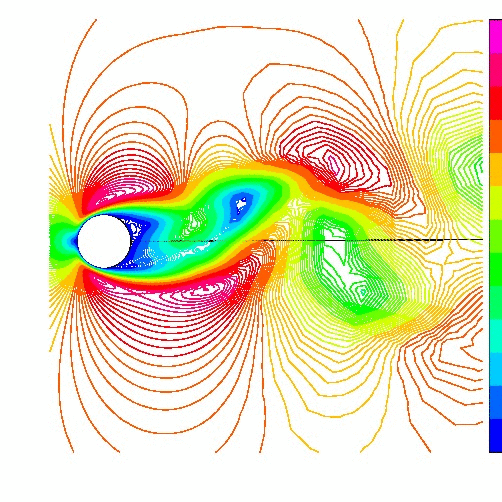This research was presented at the 12th U.S. National Congress on Computational Mechanics in Raleigh, on July 22-25, 2013. The poster presenting this research received a Best Poster Award. A pdf version of the poster is available for download.
About this Project

For a certain range of Reynolds numbers, flow passing by a cylinder will lead to a fluid dynamic instability, often referred to as von Karman vortices. These alternating, shedding vortices cause unsteady forces on the surface of the cylinder, which tend to make the cylinder oscillate; a phenomenon called 'vortex-induced vibrations'. Under certain conditions, the shedding frequency and the oscillation frequency will lock-in, which is problematic because lock-in tends to yield large-amplitude oscillations that lead to structural, lifetime-fatigue issues. In practice, frequency lock-in is observed in offshore platforms (water flowing past a pipe), turbomachinery (aerodynamic instabilities in jet-engine compressors), and airplane-wing performance (buffet). It is important that engineers can model the occurrence of lock-in to prevent the failure of structures and avoid costly engineering redesign.
This research uses a harmonic balance (HB) computational fluid dynamics (CFD) technique to solve the Navier-Stokes equations for flow past an oscillating cylinder, which is forced to move at a certain frequency and at a certain amplitude. These HB solutions are then used as basis functions for the formation of a reduced-order model based on proper orthogonal decomposition (POD) techniques. The desired POD model contains a sufficient number of modes to accurately model the temporal and spatial characteristics of the flow without retaining additional terms that slow computation time.
Ultimately, the quality of the POD-based prediction is judged against a CFD solution. This research shows that with the right choice of POD basis vectors, accurate CFD solutions may be predicted using a very small number of POD modes (fewer than six). Therefore, this research presents a novel way of accurately predicting locked-in CFD solutions. Also, this research demonstrates the dominant fluid-dynamic features of the unsteady flow for the oscillating cylinder, which sheds light on the flow physics that causes vortex-induced vibration lock-in.
Group Members Involved:
- Robert E. Kielb
- Fanny Besem
- Stephen T. Clark
- Jeffrey P. Thomas